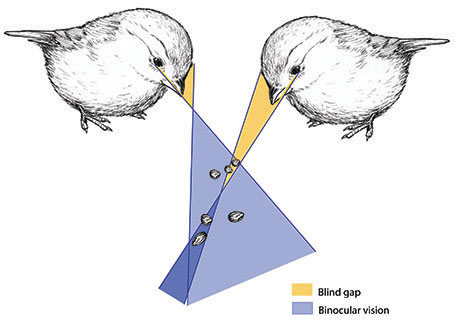The blind gap in avian binocular vision
09-21-2017
 Binocular vision has generally been associated with depth perception, contrast discrimination, etc. Interestingly, in birds, the binocular field does not necessarily start at the tip of the bill. There is actually a blind gap between the tip of the bill and the binocular field. In a recent study published in PLoS ONE, former Ph.D. student Luke Tyrrell and Prof. Esteban Fernandez-Juricic showed that this blind gap varies substantially between different bird species. This blind gap is functionally relevant because many birds use their bill as a way of grabbing food items before consuming then; hence, the larger the blind gap, the higher the uncertainty to estimate the distance and time to reach the target with the bill. Therefore, species that rely on the visual control of the bill would have smaller blind gaps, which is what the study found. The study shows that species that are pecking foragers and non-raptorial predators tend to have smaller blind gaps. Species with larger blind gaps that need control of the bill tend to have large degrees of eye movement to reduce the blind gap or longer bills. Finally, diurnal raptors tend to have large blind gaps mainly because they grab their prey with their talons instead of their bills. This study shows that the evolution of binocular vision in birds is not just about what birds can see but also about what they cannot.
Binocular vision has generally been associated with depth perception, contrast discrimination, etc. Interestingly, in birds, the binocular field does not necessarily start at the tip of the bill. There is actually a blind gap between the tip of the bill and the binocular field. In a recent study published in PLoS ONE, former Ph.D. student Luke Tyrrell and Prof. Esteban Fernandez-Juricic showed that this blind gap varies substantially between different bird species. This blind gap is functionally relevant because many birds use their bill as a way of grabbing food items before consuming then; hence, the larger the blind gap, the higher the uncertainty to estimate the distance and time to reach the target with the bill. Therefore, species that rely on the visual control of the bill would have smaller blind gaps, which is what the study found. The study shows that species that are pecking foragers and non-raptorial predators tend to have smaller blind gaps. Species with larger blind gaps that need control of the bill tend to have large degrees of eye movement to reduce the blind gap or longer bills. Finally, diurnal raptors tend to have large blind gaps mainly because they grab their prey with their talons instead of their bills. This study shows that the evolution of binocular vision in birds is not just about what birds can see but also about what they cannot.